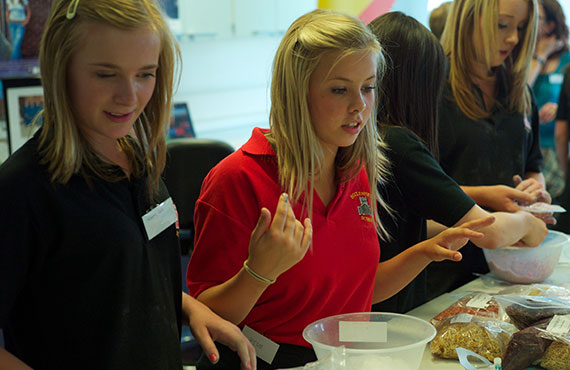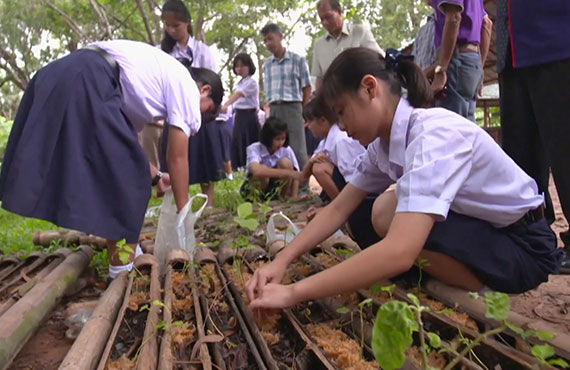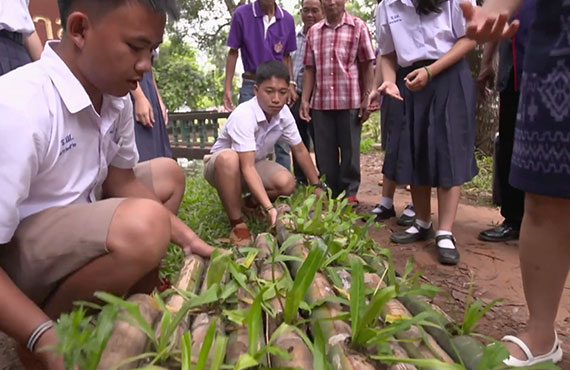About STEM Clubs (Secondary Schools)
The STEM Force Secondary School STEM Clubs are designed to actively engage students in addressing real community, national, and global challenges aligned with the United Nations’ Sustainable Development Goals (SDGs). Through authentic problem and project-based learning experiences, students have the opportunity to make a positive impact.
We encourage Secondary School STEM Clubs to collaborate with local universities, STEM ambassadors, and STEM companies when students are working on projects, and to seek their support in developing project ideas. STEM Ambassadors are encouraged to mentor students throughout their project journey.
Local government offices, universities, and companies can contribute to STEM Club projects in the following ways:
- Assisting Club leaders in identifying project problems and contexts.
- Introducing the problem and context and providing authentic documents that support the introduction and emphasize the significance of solving the problem.
- Helping students gain a deeper understanding of the problem by providing methods for conducting baseline research and data analysis for understanding the extent of the problem or facilitating expert interviews.
- Helping students to develop the background knowledge and understanding to solve the problem by providing relevant research papers that can be simplified to suit the target group; providing suggestions for inquiry-based practical activities; loaning equipment or test kits; providing suggestions for scientific investigations; provide specialist facilities; developing the students skills in using equipment, machinery, software, programming etc.
- Supporting students in developing the necessary background knowledge and skills to address the problem. This can include sharing relevant research papers tailored to the target group, suggesting inquiry-based practical activities, lending equipment or test kits, providing guidance for scientific investigations, offering access to specialist facilities, and helping students develop technical skills such as equipment, machinery, and software usage, and more.
- Mentoring the students throughout the project, providing feedback, and guiding the development of their ideas and skills.
- As students work on solving the problem, they can contribute suggestions for scientific investigations for testing parameters, models, and prototypes. They can also provide access to specialist facilities, materials, equipment, and testing labs. Mentors play a pivotal role by offering valuable feedback to help develop and refine ideas.
- Mentors can also attend communication events where students present their solutions, act as judges, provide feedback, and award certificates and prizes.


The STEM Force STEM clubs are designed to cater to the specific needs and age group of the students involved.
We provide training for teachers or club leaders to support them in establishing, planning, and running their STEM Clubs. We recommend starting small with a group of students they are familiar with and collaborating with colleagues and STEM ambassadors to run the club effectively.



To initiate student engagement and skill development, we provide downloadable examples from the Pupil Researcher Initiative (PRI), a UK-based project. These examples, including research briefs and accompanying resources, were designed to enhance science curriculum delivery and inspire students to explore the world of science, engineering, and STEM research. Each research brief presents opportunities for active learning, incorporating elements of problem-based learning, background knowledge, investigation, and communication.
Pupil (Student) Research Brief (PRB) Resources
The Pupil Researcher Initiative (PRI) was a significant curriculum development project in the UK, involving secondary schools nationwide. Its primary goal was to enhance student motivation and achievement in science education by providing innovative and stimulating curriculum materials and activities that engage students with the world of science, engineering, and STEM research. This initiative comprised several components, such as Pupil (Student) Research Briefs, Researchers in Residence, School STEM Fairs, regional and national student conferences, and a STEM Magazine (PRISM).
Specifically designed to support teaching and learning for students aged 14 to 16, the Pupil Research Briefs (PRBs) aimed to introduce fresh ideas, strategies, and contexts for experimental and investigative science. They also offered insights into the work of real research scientists and engineers as STEM professionals. Developing the PRBs pushed the boundaries of curriculum design, emphasizing the educational benefits of active student participation and providing authentic and relevant learning contexts.
The Centre for Science Education at Sheffield Hallam University, UK, developed the Pupil Research Initiative and PRBs with funding from the Engineering and Physical Sciences Research Council (EPSRC) and the Particle Physics and Astronomy Research Council (PPARC). Each research brief was tailored to a specific topic within the curriculum. Though the PRBs adopted diverse approaches, they shared a common purpose: to provide teachers and students with opportunities to experience, to the best extent possible, the thinking and working processes of science and engineering researchers. The PRBs were structured around a Problem-based Learning model, which categorized the various activities undertaken by researchers, facilitating the translation of research activities into structured curriculum materials. The model consisted of four components: research context and problem, background knowledge, investigation/problem solving, and communication.
All the Research Briefs serve as excellent stimuli for authentic STEM projects, and each PRB description includes suggestions for possible accompanying STEM projects.
Please note that the Teacher's Guides include links to the English and Scottish curricula and examination syllabi. You will need to adapt the materials to align them with your own curriculum or syllabi.
Bioengineers and Incubators
This research brief focuses on investigating human temperature control and designing an incubator tailored specifically for premature babies. Thanks to medical advancements, it is now possible to save pre-term babies at increasingly early stages of development. However, these babies often lack fully developed homeostatic processes, like temperature control. Bioengineers are continuously working on developing incubator technology that can effectively respond to the constantly changing individual needs of these babies. The research papers provided in this brief reference studies conducted on pre-term babies, which have informed bioengineers in their work.
In this brief, students and the teacher assume the roles of research scientists or engineers in a bioengineering department. The students act as new research students, while the teacher takes on the role of the Research Director, serving as their supervisor. The department seeks funding for a new research project aimed at developing an incubator specifically for very early pre-term babies—those born more than 12 weeks premature. The students are assigned the task of researching a specific aspect of the issue. They utilize the findings of their research to write an investigation report and create a poster presentation for a research seminar. During the seminar, they will have the opportunity to learn about the work conducted by other research groups. They will then incorporate their research findings and the work of others into a research proposal, which will be submitted to the Research Council (represented by the teacher) for consideration of support. The teacher may choose to award the "grant" to the most promising research proposal.
STEM project suggestions: In addition to the assigned tasks, students can further explore the latest developments in neonatal care, an area characterized by active research. They could design an electronic temperature monitor/controller that triggers an alarm if the temperature becomes too low or if the moisture level becomes too high (indicating sweating in the baby). Another project idea is to design, develop, test, and refine a functional model of an affordable, portable, and user-friendly incubator capable of meeting the needs of early pre-term babies.
- Research Brief Bioengineers and Incubators - Study guide.pdf
- Research Brief Bioengineers and Incubators - Teachers notes.pdf
Clear Solutions
This research brief draws inspiration from an actual research project focused on the use of microorganisms to remove dyes from wastewater, specifically in the context of a fabric dyeing plant. The primary goal of this brief is to task students with conducting an investigation to assess the effectiveness of utilizing immobilized yeast columns for extracting dye. By designing and executing their investigation, students will gather data that can be analyzed to draw conclusions and provide suggestions regarding the efficacy of this dye extraction method.
STEM project suggestions: The brief acknowledges that due to time constraints, students may choose to conduct a subset of the possible investigations. However, if ample time is available, students have the opportunity to carry out all the investigations. Moreover, they can go beyond the investigation and engage in designing, developing, testing, and refining a system capable of removing dyes from wastewater.
- Research Brief Clear Solutions - Study guide.pdf
- Research Brief Clear Solutions - Teachers notes.pdf
Out of “Site,” Out of Mind
This research brief involves students assuming the role of new research students within a university environmental chemistry unit. The unit has been approached by a waste disposal company to recommend the most suitable natural material, or combination of materials, to serve as a liner for a landfill site. The students' tasks include reading background papers, reporting their findings to their team, and subsequently planning and conducting investigations. A comprehensive report must be compiled and submitted to the waste disposal company, which will utilize it in an application to the county council to obtain a license.
STEM project suggestions: As an extension to this brief, students could engage in designing, developing, testing, and refining a functional model of an environmentally friendly landfill site. Alternatively, they could explore alternative environmentally friendly approaches or methods for managing household or school waste. These STEM projects encourage students to think creatively and propose sustainable solutions to waste management challenges.
- Research Brief Out of “Site,” Out of Mind - Study guide.pdf
- Research Brief Out of “Site,” Out of Mind - Teachers notes.pdf
Portable Hydroelectric Power Plants (PHEPPS)
In this research brief, students step into the shoes of researchers within a university engineering department. Their task is to conduct research on the design of a Portable Hydroelectric Power Plant (PHEPP) based on real-world work conducted at the university. The students will delve into the factors that influence the electromotive force (e.m.f.) generated by a generator. Additionally, they will explore blade design for the turbine, aiming to optimize efficiency and maximize the speed at which the generator rotates.
STEM project suggestions: As an extension to this brief, students can engage in the design, development, testing, and refinement of a functional model of their PHEPP. This model can be tailored for deployment in remote communities lacking access to electricity. Through this STEM project, students have the opportunity to contribute to the advancement of renewable energy solutions and address energy needs in underserved areas.
Plants in Space - Life-Sustaining Units for Long Spaceflights
In this research brief, students step into the roles of research scientists within a university's bio astronomy department. Their task is to conduct preliminary investigations for a competition focused on designing a life-sustaining unit to support a crewed flight to Mars. The students engage in research related to various aspects of photosynthesis to identify the most suitable plant species for inclusion in the life-support system. They also explore human physiology to understand the crew's oxygen and food requirements during the journey.
STEM project suggestions: As an extension of this brief, students can undertake the design, development, testing, and refinement of a functional model representing a life-sustaining unit for a crewed flight to Mars. This project allows students to explore the complexities of sustaining life in space and fosters innovative thinking in creating solutions for long-duration space missions.
- Research Brief Plants in Space - Study guide.pdf
- Research Brief Plants in Space - Teachers notes.pdf
We are excited to empower students and shape a future generation of STEM enthusiasts through our Secondary School STEM Clubs. Together, let's embrace the opportunities for learning, collaboration, and innovation that lie ahead.
